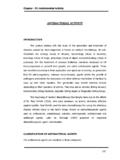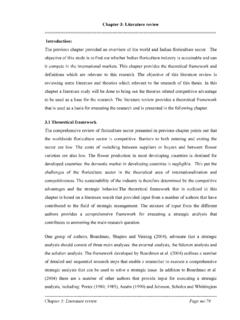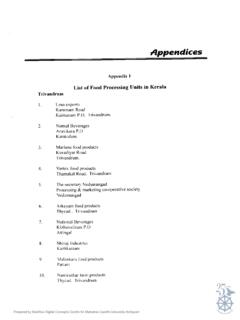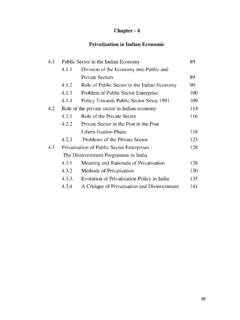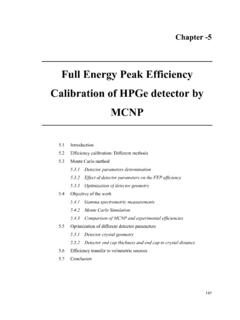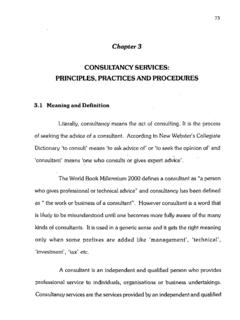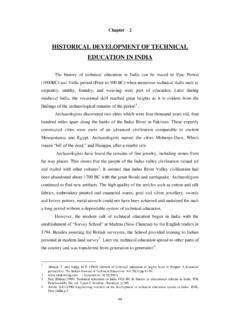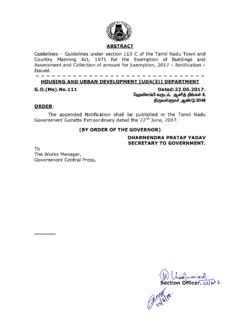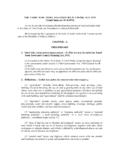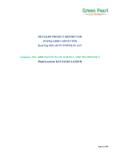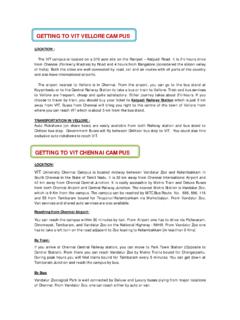Transcription of CHAPTER - I INTRODUCTION AND DESIGN OF …
1 1 CHAPTER - I INTRODUCTION AND DESIGN OF THE STUDY INTRODUCTION India is in its sixth decade of independence and it is on the threshold of the 21st century. Despite the five decades of planned economic development, the achievement in the sphere of women empowerment is considerably discouraging. Hence more intense researches on women development are recognized as the need of the hour. The present study makes it relevant in this context. In India, women constitute nearly 50 per cent of total population. Majority of them, especially in the rural areas, depend upon men for their livelihood and continue to be voiceless section, though economic value is not attached to women s role. In bringing up the family, their contribution is very significant. Since household health and nutrition are generally in the hands of women, the empowerment of them is necessary for ensuring their own welfare and also the well being of the entire household.
2 Real empowerment of women would happen only by adding more value on their contribution to the family and the society. Women, therefore is a powerful part of social and economic setup of the country. In the ancient period, they were treated as builds of the society and they ran the family successfully. Now in India, Women s contribution to the 2 industrial sector is rapidly growing in multidimensional basis. Government encourages the women as independent and self sustainable persons in the society. Women empowerment through self help group constitutes an emerging and fast growing trend towards social and economic development of the nation. Self Help Groups (SHGs) are one of the innovative and much needed schemes to accelerate the women entrepreneurship, women s self employment and women empowerment. This concept was successfully implemented in Bangladesh and now in India.
3 It has become the wise tool to improve the social and economic development. Government also provides various financial and non-financial assistance to promote the Self Help Groups for women empowerment. Banks and financial institutions have also realized the impact of the Self Help Groups. Hence they are channelising their funds for women and rural development through Self Help Groups. Historical Perspectives According to Wallace. et al, (1991)1 the role of women is increasingly recognized in the development of the Third World Nations particularly in collective groups or cooperatives in rural areas. Housman (1992)2 stated that women constitute about half of the world population and contribute about two-third of all the labour hours worked by the human race, though they are the primary providers of childcare and suppliers of many of the necessities of day to day life for themselves and their families.
4 3 Increasingly, women play a major role in the formal economies regulated by society and are continue to be a large part of the informal economics. Self Help Groups in Tamil Nadu Sasikumar D. (2009)3 stated in his article that the Government of Tamil Nadu established the Tamil Nadu Corporation for Development of Women Limited for the empowerment of women in December 1983. Tamil Nadu Women Development Project, funded by the International Fund for Agricultural Development, was started on an experimental basis during 1991-1992 in Dharmapuri district. It received its first growth thrust and was extended to all other districts in a phased manner under the State Budget. It is more popularly known as Mahalir Thittam . Government of Tamil Nadu initiated Mahalir Thittam throughout the State for the overall upliftment of women.
5 Women Activities Under Various Self Help Group Schemes Women Self Help Groups were formed based on the motives like social and economic welfare, awareness of women s rights and duties, building leadership qualities, skill development, etc. Tamil Nadu Women Empowerment and Poverty Reduction Project was launched to reduce poverty and empower the women. Apart from regular savings, Self Help Groups are engaged in business activities to uplift themselves financially and economically. Self Help Groups in the state are engaged in giving training for sewing, coir knitting and sale, manufacturing of soaps, manufacturing of toys and wires, manufacturing of blue, bringingup of mushrooms etc. Many workshops were conducted for 4 the welfare and awareness of self help group members and people community. Watershed development, Agricultural extension, Health and Sanitation programmes, AIDS awareness programmes, Family welfare programmes etc.
6 , are some of the vital activities in this context. Public distribution scheme outlets are also run by Self Help Groups in Tamil Nadu. STATEMENT OF THE PROBLEM Two approaches are commonly used by the development agencies to examine the empowerment of women. Empowerment in economic status through (i) Economic intervention such as employment, income generation and access to credit and (ii) Integrated rural development programmes in which, strengthening women s economic status is the only component along with education, literacy, the provision of basic needs and services and fertility control. India is one of the developing countries in the world. Even now nearly 30 per cent of the Indians belong to below poverty line. So their standard of living can be improved through the Self Help Group s Activities. Hence as of today, the role of Self Help Groups in the context of improving women empowerment has become a vital one.
7 Women empowerment could be studied in terms of their influence over economic resources of the family, participation in the household decision making in money matters and on the decisions pertaining to general welfare of the householders. Women empowerment also depends on self development which could be realized through the growth of personality in terms of ability of rural women to influence and participate in the 5 decision making, freedom to start new micro enterprises, income generation capacity, to join in adult education programme if they are illiterate or to pursue their higher education through distance mode when they are literates The self help group women are also capable of overlaying the prevalence of some evil factors like gender discrimination, gender bias and social attitudes towards women in society. Self Help Group women s ability to influence the behavior of others and ability to have influential power, improvement in the technical and managerial skill of Self Help Group members, attendance in training programme and Self Help Group meeting, leadership rotation practice and intensity of involvement in Self Help Group activities, etc, are the other aspects of analyzing rural women empowerment which are seen in self help group women.
8 The present study is focused to examine the performance of women development programme in terms of Self Help Groups and to analyze the extent of empowerment of women through Self Help Groups in the Salem district of Tamil Nadu. Self Help Group members are mainly households engaged in agriculture and its other allied activities. The performance of women development programme could be judged in terms of formation of Self Help Groups in the multiplication of such groups, the extent of saving mobilization among the Self Help Groups, availing bank credit under various anti-poverty programmes and in the rotation of savings among themselves and level of development of rural micro entrepreneurial activities by the efforts of Self Help Group members. 6 NEED FOR THE STUDY Even after six decades of planned development, Indian women, except a privileged minority, have not achieved expected success in the main stream of life.
9 The position of woman and her status in any society is an index of the civilization. Self-help groups are at present playing a vital role in empowering women in all respects. Salem district is one of the developed districts in the state of Tamilnadu. It constitutes around four per cent of the total SHGs in Tamilnadu and holds the ninth place in Tamilnadu with regard to the number of SHGs formed. In view of the foregoing factors, the researcher has undertaken the present study for highlighting the empowerment status of women through SHGs in Salem district, Tamilnadu. SCOPE OF THE STUDY The proposed research is to specially focus on the growth of women Empowerment through Self Help Groups in the Salem district. This research would also focus on the further development of the Self Help Groups and find out the promotional schemes and systems available to the growth of Self Help Groups.
10 Rural development and industrialization are possible only with the help of the Self Help Groups. This research would analyse and evaluate the entire position of Self Help Groups, Women Empowerment and Women Entrepreneurship. The existence of gender bias all over the world, particularly in developing countries is quite boundless. The government through its policies and programmes evolve strategies not only to reduce the gender inequalities 7 but for the overall development of women. The important aspect of the programmes, in recent times, is encouraging the formation of Self Help Groups that will foster the needs of women development. The scope of present study is to analyze the women s development Programmes and rural women empowerment in the context of Self Help Groups in the following 9 taluks of Salem district, Tamilnadu.
